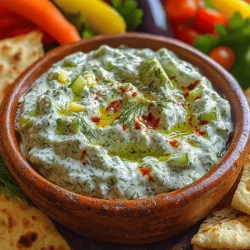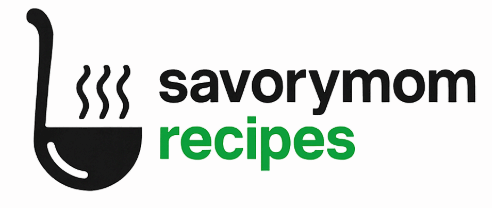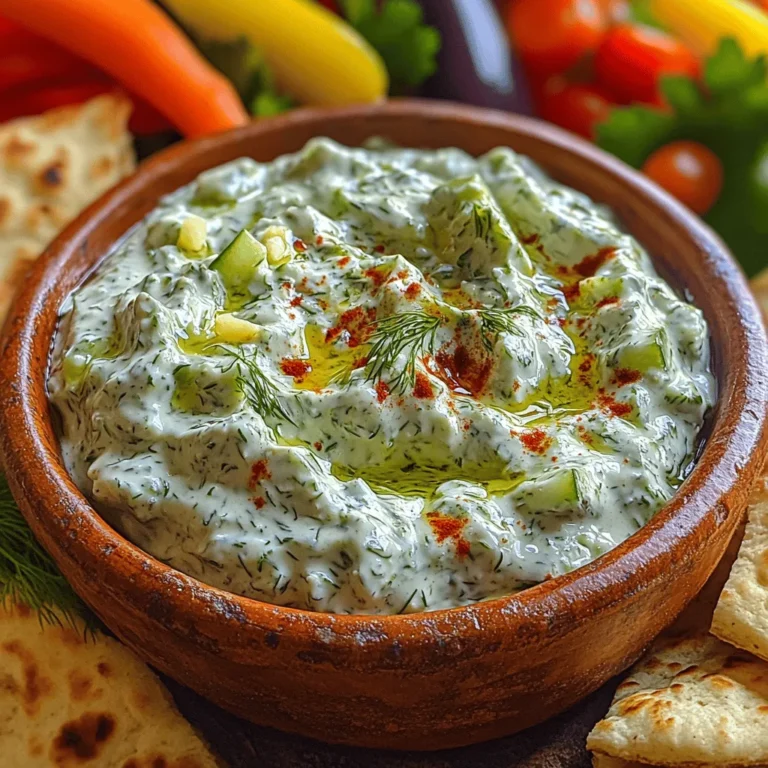Refreshing Cucumber & Eggplant Tzatziki
Tzatziki is a beloved dip that embodies the flavors of the Mediterranean, traditionally made with creamy yogurt, crisp cucumbers, garlic, and a splash of olive oil. This refreshing concoction has become a staple in Mediterranean and Middle Eastern cuisine, often served alongside grilled meats, pita bread, or simply enjoyed as part of a meze platter. The cool, tangy profile of tzatziki makes it a perfect accompaniment to warm dishes, providing a delightful contrast that enhances the overall dining experience.
However, this recipe takes a bold step beyond the traditional by introducing roasted eggplant alongside the classic cucumber. This unique twist not only adds a layer of depth and richness to the tzatziki but also brings an exciting new texture and flavor that elevates this classic dip. The smoky, creamy notes of roasted eggplant harmonize beautifully with the crispness of cucumber, creating a refreshing and satisfying dip that is sure to impress.
In addition to its delectable taste, this cucumber and eggplant tzatziki is packed with health benefits. Greek yogurt serves as a protein-rich base that supports gut health, while cucumbers are hydrating and low in calories, making them an excellent choice for a light snack. Eggplant, on the other hand, is known for its high antioxidant content and dietary fiber, promoting heart health and digestion. Together, these ingredients not only create a delicious dish but also contribute to a balanced and nutritious diet.
Understanding Tzatziki: A Traditional Mediterranean Dip
Tzatziki has deep roots in Mediterranean and Middle Eastern culinary traditions. It is often associated with Greek cuisine, where it is frequently served as an appetizer or side dish. The essence of tzatziki lies in its simplicity, typically featuring yogurt, cucumbers, garlic, and herbs like dill or mint. This combination offers a cooling effect, making it particularly popular in the warmer months.
Traditionally, tzatziki is enjoyed as a dip for pita bread or as a topping for grilled meats such as gyros or souvlaki. Its versatility allows it to shine in various settings, from casual family dinners to festive gatherings. The presence of tzatziki on the table is often a sign of hospitality, as it invites guests to share in a communal experience of flavor and enjoyment.
This recipe for cucumber and eggplant tzatziki introduces exciting variations to the traditional formula. By incorporating roasted eggplant, the dip gains a new dimension of flavor that complements the refreshing qualities of cucumber. This innovative approach not only honors the essence of tzatziki but also reinvents it for modern palates.
Ingredients Breakdown
To create this refreshing cucumber and eggplant tzatziki, you will need a few key ingredients that are both nutritious and flavorful:
1. Cucumber: The star of any tzatziki, cucumbers are rich in water content, making them incredibly hydrating. They are low in calories and provide a refreshing crunch that balances the creaminess of the yogurt. Cucumbers are also packed with vitamins and minerals, including vitamin K and potassium, which are essential for overall health.
2. Eggplant: This versatile vegetable adds a unique twist to the classic tzatziki. Eggplant is known for its high antioxidant levels, particularly nasunin, which is beneficial for brain health. It is also an excellent source of dietary fiber, aiding in digestion and promoting heart health. When roasted, eggplant develops a smoky flavor and creamy texture that enhances the dip’s complexity.
3. Greek Yogurt: A staple in Mediterranean cuisine, Greek yogurt is thicker and creamier than regular yogurt, making it the perfect base for tzatziki. It is rich in protein and probiotics, which support gut health and help maintain a balanced digestive system. The tangy flavor of Greek yogurt complements the other ingredients beautifully, creating a well-rounded dip.
Optional variations of this recipe include using low-fat or full-fat Greek yogurt, depending on your dietary preferences. You can also experiment with different herbs, such as mint or parsley, to customize the flavor profile of your tzatziki.
Step-by-Step Instructions
Preparing the Eggplant
To begin crafting your cucumber and eggplant tzatziki, the first step is to prepare the eggplant. Roasting the eggplant brings out its natural sweetness and smoky flavor, which will enhance the overall taste of the dip.
1. Preheat the Oven: Start by preheating your oven to 400°F (200°C). A higher temperature will help achieve that perfect roasted texture, allowing the eggplant to caramelize and develop a rich flavor.
2. Prepare the Eggplant: Rinse the eggplant under cold water and pat it dry. To prevent the skin from bursting during roasting, use a fork to prick the skin in several places. This step is crucial, as it allows steam to escape while the eggplant cooks, ensuring even roasting.
3. Roast the Eggplant: Place the prepared eggplant on a baking sheet lined with parchment paper. Drizzle a little olive oil over it, and season with salt and pepper to taste. Roast the eggplant in the preheated oven for about 30-40 minutes or until the skin is wrinkled and the flesh is tender. You can test for doneness by inserting a fork into the flesh; it should be soft and easily pierced.
4. Cool and Scoop: Once roasted, remove the eggplant from the oven and let it cool slightly. After cooling, carefully scoop out the flesh with a spoon, discarding the skin. The roasted eggplant flesh should be creamy and flavorful, ready to be incorporated into your tzatziki.
Grating the Cucumber
While the eggplant is roasting, you can prepare the cucumber to complete the tzatziki base.
1. Select the Cucumber: Choose a fresh cucumber, preferably an English cucumber or Persian cucumber, which tend to have fewer seeds and a thinner skin. These varieties will provide a crisp texture and refreshing taste.
2. Grate the Cucumber: Using a box grater or a food processor, grate the cucumber into a bowl. Aim for medium to fine shreds, as this will help integrate the cucumber into the tzatziki smoothly.
3. Drain Excess Water: Cucumbers have a high water content, and draining excess moisture is essential to prevent the tzatziki from becoming watery. Place the grated cucumber in a clean kitchen towel or cheesecloth and squeeze out as much liquid as possible. This step will ensure that your tzatziki has the right consistency—thick and creamy, rather than runny.
With the eggplant roasted to perfection and the cucumber grated and drained, you are well on your way to creating a deliciously unique cucumber and eggplant tzatziki that will delight your taste buds and impress your guests. Stay tuned for the next sections, where we will combine all the elements and add the finishing touches to this refreshing dip.
{{image_2}}
Removing Excess Moisture
When preparing tzatziki, one crucial step is removing excess moisture from the cucumber. This process is vital to maintain the tzatziki’s creamy consistency and prevent it from becoming watery. A watery tzatziki can dilute the flavors and lead to a less enjoyable eating experience.
Techniques for Grating and Draining Cucumber
To effectively grate and drain cucumber, follow these steps:
1. Choose the Right Cucumber: Opt for a firm cucumber, preferably an English cucumber or Persian cucumber, which have fewer seeds and thinner skin.
2. Grate the Cucumber: Using a box grater, grate the cucumber into a bowl. You can use the largest holes for a coarser texture or the smaller ones for a finer result.
3. Salt the Cucumber: After grating, sprinkle a pinch of salt over the cucumber. This step helps draw out moisture.
4. Drain the Cucumber: Let the salted cucumber sit in a colander for about 10-15 minutes. The salt will extract liquid, allowing you to achieve the desired consistency.
5. Squeeze Out Additional Moisture: After draining, use a clean kitchen towel or cheesecloth to squeeze out any remaining moisture. This technique is essential for ensuring a thick and satisfying tzatziki.
Combining Ingredients
Once your cucumber is perfectly drained, it’s time to combine it with the roasted eggplant and Greek yogurt. The combination of these ingredients creates a balanced flavor profile that is both refreshing and satisfying.
1. Mixing the Ingredients: In a mixing bowl, combine the drained cucumber, roasted eggplant (which should be cooled and mashed), and Greek yogurt.
2. Gentle Mixing: Use a spatula or wooden spoon to gently fold the ingredients together. This method maintains the chunkiness of the roasted eggplant and cucumber while incorporating them evenly with the yogurt.
Adding Flavor
The true magic of tzatziki lies in its flavor-enhancing ingredients. Garlic, dill, lemon juice, and olive oil contribute significantly to the overall taste.
1. Garlic: Mince one or two cloves of garlic, depending on your preference for pungency. Garlic adds a sharp, aromatic quality that elevates the dish.
2. Fresh Dill: Finely chop fresh dill and add it to the mixture. Dill provides a fresh and slightly tangy flavor that pairs beautifully with yogurt and cucumber.
3. Lemon Juice: Squeeze half a lemon to extract its juice and mix it into the tzatziki. The acidity brightens the dish and balances the creaminess of the yogurt.
4. Olive Oil: Drizzle a tablespoon of high-quality extra virgin olive oil into the bowl. This enriches the tzatziki and adds a luxurious mouthfeel.
5. Seasoning: Finally, season with salt and freshly cracked black pepper to taste. Seasoning is essential as it amplifies the flavors and ties the ingredients together.
Chilling and Serving
Once your tzatziki is combined, it’s best to chill it before serving. Chilling not only enhances the flavor but also allows the ingredients to meld beautifully.
1. Refrigerate: Cover the bowl with plastic wrap or transfer the tzatziki to an airtight container. Let it chill in the refrigerator for at least 30 minutes. This resting time allows the flavors to develop fully.
Serving Options and Pairings
Cucumber and eggplant tzatziki is incredibly versatile. Here are some serving suggestions:
– Dip: Serve it as a refreshing dip alongside pita bread, fresh vegetable sticks, or crackers for a delightful appetizer or snack.
– Spread: Use it as a spread in wraps, sandwiches, or on grilled meats to add a cool contrast to the dish.
– Accompaniment: Pair it with grilled meats, roasted vegetables, or as part of a mezze platter for a complete Mediterranean experience.
Presentation Tips for a Stunning Serving
The visual appeal of your tzatziki can elevate the dining experience. Here are some presentation tips:
– Garnish: Top the tzatziki with a sprinkle of fresh dill or a few slices of cucumber for a fresh touch.
– Drizzle Olive Oil: Just before serving, drizzle a little extra virgin olive oil on top. This not only enhances the flavor but also gives a beautiful sheen to the tzatziki.
– Serve in a Bowl: Choose a colorful or intricately designed serving bowl to showcase the tzatziki’s creamy texture and vibrant colors.
Health Benefits of Cucumber & Eggplant Tzatziki
Cucumber and eggplant tzatziki is not just delicious; it also comes with several health benefits.
1. Low-Calorie Option: This tzatziki is a lower-calorie dip alternative compared to many creamy dressings and dips, making it suitable for those watching their calorie intake.
2. Nutrient-Rich Ingredients: Cucumbers are hydrating and low in calories, while eggplants are rich in fiber, vitamins, and antioxidants. Together, they create a nutritious dip that supports overall health.
3. Diet Compatibility: This tzatziki aligns well with various diets, including Mediterranean, vegetarian, and even vegan when using plant-based yogurt. It can easily fit into a balanced meal plan.
4. Versatile Meal Enhancer: Whether you’re using it as a dip, spread, or sauce, tzatziki complements a wide range of dishes, making it a fantastic addition to any meal.
Conclusion
The cucumber and eggplant tzatziki recipe is a refreshing and nutritious dish that brings together vibrant flavors and wholesome ingredients. Its creamy texture and zesty profile make it a delightful addition to any meal or gathering. Not only does it provide a host of health benefits, but it also serves as a versatile dip or spread that can elevate your culinary creations.
Encourage your family and friends to experience this delightful tzatziki for themselves. With its simple preparation and refreshing taste, it’s bound to become a beloved staple in your kitchen. So, grab those cucumbers and eggplants, and let’s make some tzatziki that will impress everyone at your next gathering!


